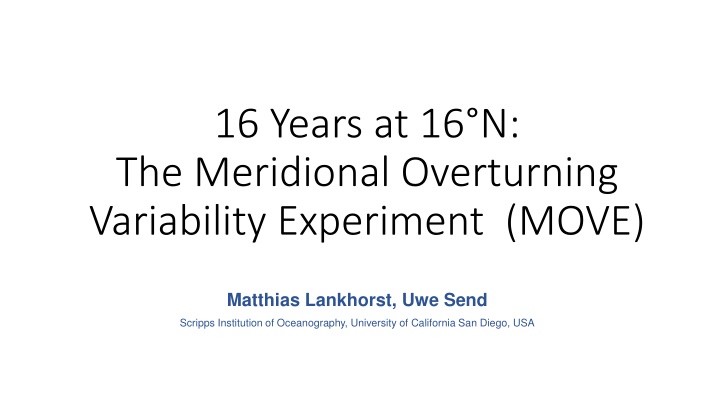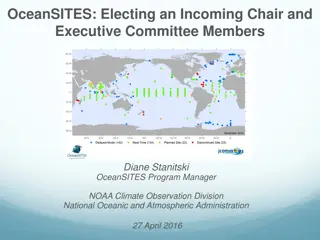
MOVE Array: Observing Meridional Overturning Variability at 16N
The MOVE Array project, occupied since 2000, observes the deep southward branch of the AMOC at 16N. It provides crucial data on the Atlantic Meridional Overturning Circulation, aiding in climate research. The project's data holdings are available in delayed-mode quality, supporting global ocean observing systems.
Download Presentation

Please find below an Image/Link to download the presentation.
The content on the website is provided AS IS for your information and personal use only. It may not be sold, licensed, or shared on other websites without obtaining consent from the author. If you encounter any issues during the download, it is possible that the publisher has removed the file from their server.
You are allowed to download the files provided on this website for personal or commercial use, subject to the condition that they are used lawfully. All files are the property of their respective owners.
The content on the website is provided AS IS for your information and personal use only. It may not be sold, licensed, or shared on other websites without obtaining consent from the author.
E N D
Presentation Transcript
16 Years at 16N: The Meridional Overturning Variability Experiment (MOVE) Matthias Lankhorst, Uwe Send Scripps Institution of Oceanography, University of California San Diego, USA
MOVE Array (16N): Introduction Occupied since 2000 Initially German project Now funded by NOAA COD Under CLIVAR auspices Presently 3 sites with moorings, 2 of which with PIES Previously up to 7 sites (additional moorings and PIES) Observation of the deep, southward branch of the AMOC (Atlantic Meridional Overturning Circulation)
MOVE Transport Time-Series 16 years of observations Note that "down" denotes stronger flow Low-pass filtered Decadal-scale variability observed
MOVE: Interannual Variability in Density Observations Geopotential difference, i.e. dynamic height, at MOVE1 and MOVE3 "Trends" (interannual variability) shown by linear fits Transport trends (previous slide) can be allocated to changes at MOVE1 (early years) and MOVE3 (later years)
Use of MOVE observations: IPCC AR5 Annual "State of the Climate" reports Relation to Rest of Atlantic: Correlation between MOVE transport and SSH from AVISO (satellite altimetry) Figure courtesy E. Frajka-Williams MOVE transports represent pan- Atlantic pattern
Data Holdings in OceanSITES: All mooring data available in delayed-mode quality (fully annotated metadata, fully quality-controlled, best calibrations applied) All PIES pressure data from recovered instruments available in delayed-mode quality (dito...) Pending: PIES acoustic travel time data (just got CF metadata in 2016) Real-time data (sacrificed to reduce backlog of PIES data) Derived transports (available from project website in non-OceanSITES format, plan to transfer to OceanSITES) http://mooring.ucsd.edu/index.html?MOVE Acknowledgements: MOVE is supported by NOAA (USA), and MOVE data are freely available via OceanSITES. OceanSITES is a contribution to the Global Ocean Observing System. MOVE was supported by BMBF (Germany) in the past. The altimeter products were produced by Ssalto/Duacs and distributed by Aviso with support from Cnes.











